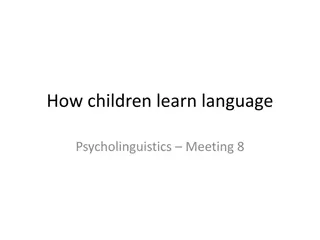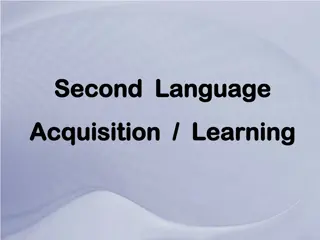Enhancing Language Acquisition Through Practice and Application
Explore the practice and application of language acquisition strategies, focusing on building background knowledge, providing comprehensible input, and designing activities to enhance learning for Limited English Proficient students. Learn about creating application activities that align with content and language objectives, and discover Stephen Krashen's theory of language acquisition. Understand the importance of linking practice activities to specific lesson objectives to promote fluency and meaningful language development.
Download Presentation

Please find below an Image/Link to download the presentation.
The content on the website is provided AS IS for your information and personal use only. It may not be sold, licensed, or shared on other websites without obtaining consent from the author. Download presentation by click this link. If you encounter any issues during the download, it is possible that the publisher has removed the file from their server.
E N D
Presentation Transcript
THE SIOP MODEL: PRACTICE/APPLICATION Tina Kelman & Wendy Burt
Lets Review Lesson Preparation Building Background Comprehensible Input Strategies Interaction Practice & Application Lesson Delivery Review/Assessment
Practice & Application Superman
Practice & Application Content Objectives: Identify a variety of ways for students to enhance learning through hands-on practice. Create application activities that extend the learning in new ways and relate to language or content objectives.
Practice & Application Language Objectives: Design activities that integrate different language skills as students practice new content knowledge. Discuss the importance of linking practice and application activities to specific lesson objectives.
Practice & Application Limited English Proficient (LEP) students English Language Learners (ELLs)
Language Acquisition Stephen Krashen s 5-pronged theory of Language Acquisition
Language Acquisition Language acquisition is a subconscious and intuitive process much like how children pick up their first language.
Language Acquisition The monitor: If students learn language through rules, rather than naturally, fluency will be delayed.
Language Acquisition The natural order of acquisition: ELLs will first acquire that which has the most meaning, form comes later.
Language Acquisition Providing comprehensible input to acquire language.
Language Acquisition The affective filter: a cognitive shut-down if anxious.
Knowing vs. Doing Madeline Hunter (1982) said: The difference between knowing how something should be done and being able to do it is the quantum leap in learning new learning is like wet cement, it can be easily damaged. A mistake at the beginning of learning can have long-lasting consequences that are hard to eradicate (p.71).
Practice & Application It is essential that students acquiring English have multiple, daily opportunities to practice and apply what they are learning for two reasons: Students are more likely to retain new information if they immediately put it to use 1. Teachers can assessstudents learning while they are practicing and applying their new understanding 2.
Practice & Application These opportunities for practicing and applying new learning must occur regularly within each lesson, not just at its conclusion.
Practice & Application Learning to fly
Fortune Teller Fold the bottom (short end) of a sheet of paper so that it is aligned with one side of the paper. Crease side making a big triangle. Cut the extra piece of the paper so that only the triangle remains. Fold the triangle in half to make a smaller triangle. Crease the edges well. Unfold the FT completely (square with lines to the center). Fold each of the four corners into the very center of the square (do not let the sides overlap). Turn the FT over and fold each of the new corners into the center again. Crease all the edges well! 1. 2. 3. 4.
Fortune Teller 5. Fold the FT in half to form a rectangle. 6. Fold the FT in half one more time so that it is one small square. 7. Unfold the last two folds 8. Gently pull out the square flaps and insert your index fingers and thumbs of the FT in order to use.
Fortune Teller Add these questions to your flaps: How much material should be practiced at one time? How long should the practice sessions be? How often should the practice sessions be? How will they know if they have done well? You will answer these questions as we go through this session.
3 Components of Practice & Application Hands-On Practice with New Knowledge Application of Content and Language Knowledge in New Ways Integration of All Language Skills
Practice & Application Three-Minute Pause provides a break in large sections of content Tell students to turn to a partner: Summarize Key Ideas Thus Far Provides a chance for students to stop, reflect on the concepts and ideas that have just been introduced, make connections to prior knowledge or experience, and seek clarification. Add your own thoughts Pose clarifying questions to your partner, another group or the teacher
Practice & Application Just like riding a bike Training wheels Talking about experience Listening to others describe the experience Observing others Help from others Independent practice
Practice & Application Remember! There is a difference between talking about riding a bike, and actually riding it. Just as there is a difference between classroom notes on how to solve inequalities in Algebra, and actually solving them.
Practice & Application Hands-on materials and/or manipulatives provided for students to practice using new content knowledge Activities provided for students to apply content and language knowledge in the classroom Activities integrate all language skills (i.e., reading, writing, listening and speaking)
Practice & Application Meaningful practice allows teachers the opportunity to observe the extent to which all students, especially English learners, understand new information and concepts
Practice & Application Practice and application should include not only end-of-unit activities, but also opportunities to practice and apply what students have learned during lessons When are kids going to learn the vocabulary & language if we never give them the opportunity to use it?
Practice & Application Practice helps master skills Reading Writing Listening Speaking Proficiency depends on opportunities for comprehensible input and targeted output
Practice & Application Carefully choose activities in lesson Must target objectives Differentiation Activities must support students progress
Hands-On Practice with New Knowledge Hands-on materials/manipulatives Makes practice more relative & meaningful Increases chances of mastery Enhances overall practice session Connects abstract to the concrete Hands-on materials AbSt AcT Concrete
Studies Show that We Learn 10% of what we READ 20% of what we HEAR 30% of what we SEE 70% of what is DISCUSSED with others 80% of what we EXPERIENCE personally 90% of what we TEACH others
Application of Content and Language Knowledge in New Ways Questions to consider Answers to remember How much material should be covered at once? Small, meaningful amounts of material Short practice times How long in time should practice periods be?
Practice & Application Questions to consider Answers to remember How often should students practice? New material Practice frequently How will students know how well they have done? Old material Space sessions Give specific feedback
Practice & Application - Graffiti In the version of graffiti described here, each group uses a different colored marker so that everyone can identify which group made which contribution to the charts. After a specified period (usually no more than three to five minutes), and at a specific signal, each group rotates to the next chart page until the group has traveled full circle and arrived back at its page. The rotation and recording aspect of the strategy should take about 15 to 20 minutes. If groups have too much time at any chart page, there won t be anything for subsequent groups to write. Subsequent groups may put checkmarks beside ideas to agree with them, may write disagreements beside items already recorded, or may add new information and ideas to the chart page.
Applying Knowledge Activities to apply content & language knowledge Discussing and doing make concepts concrete Involvement in relevant & meaningful application
What is meaningful practice? Practice that is directly tied to a standard
Practice & Application-Vygotsky Correcting Errors Zone of Proximal Development which is the difference between what a learner can do without help and what he or she can do with help. Zone of Proximal Development (can be learned with scaffolding ) Level of development currently out of reach Current level of development
ZPD Examples A student is able to perform simple addition when working with a teacher or parent, but is frustrated when performing the task alone. By guiding the student to use tools and strategies, and by asking questions about why he/she is using each tool or strategy, the student is able to fortify knowledge and eventually add independently. A 16 year old is able to effectively drive forward and backward but cannot parallel park. Through targeted guidance from a teacher, the child is able to learn how to park. A child is struggling to learn how to read. By working with the student to teach how to sound out words and use other word recognition strategies, the child is able to learn to read. An aspiring swimmer is attempting to learn a difficult dive. Knowing the strengths that she possesses in other diving techniques, her coach is able to directly target her instruction so that she can confidently conquer the dive.
Language Skills Activities integrate all language skills Reading, writing, listening & speaking Read what we write Talk about what we read Listen to others talk about they read
Language Skills L1 speaking & listening acquired first L2 reading & writing acquired first All skills are interconnected Different learning styles
Language Skills Writing Reading Language Speaking Listening
Turn and discuss Think about a college or graduate school course. What is one activity you remember well? What made it memorable? Did it involve different learning styles or senses? Now, think about a recent lesson you taught or observed. Was there an activity that would be memorable for the students? If not how could the activity have been more engaging and unforgettable? Did you incorporate all four language domains? Explain to a partner why it is important to link practice & application activities to the learning objectives.
TPR Create your own TPR signals for the different components of Practice and Application Practice your signals Each group presents to the whole group
Create your own TPR movement Hands-On Practice with New Knowledge Application of Content and Language Knowledge in New Ways Integration of All Language Skills
Practice & Application Activities Bingo BYO Jeopardy Poetry & Patterns Math Haikus Graphic Organizers Jigsaw projects Vocabulary Go Fish Chants Songs Texas Two Step Family Feud Student created word problems Student created test questions Teach concepts to another student Discussion circles Solving problems in cooperative groups
Discussion Questions What adjustments & techniques can a teacher use to provide ELs with successful experiences while they read, write, listen, & speak about new information? What materials could you use in your classroom to meet all language skills? Think back to a lesson you have given or been a part of. What could have been done differently to ensure meaning for all learners?
Conclusion Integrate 4 language components Practice & application are essential for mastery Patience with errors Enhance with hands-on activities Not all skills are linked to an objective























